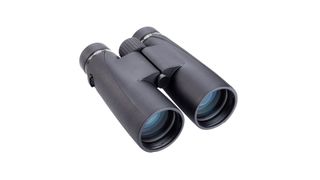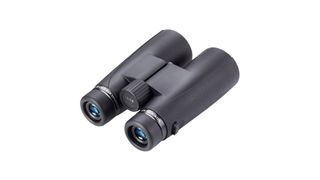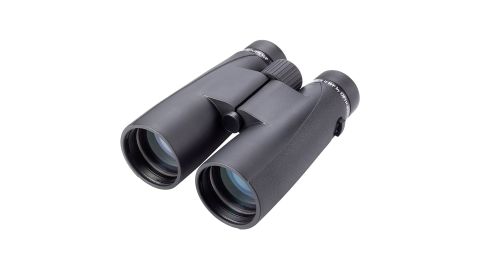Space Verdict
Opticron's roof prism binoculars are great to use and deliver clear sharp views of the night sky, but alternatives may offer better value for money.
Pros
- +
Light weight
- +
Waterproof
- +
Fully multi-coated
- +
Quality BAK4 glass
- +
Nice ergonomics
Cons
- -
Reduced field of view
- -
Lacking premium feel
- -
Short strap on case
Why you can trust Space.com
Opticron's Adventurer II WP 10x50 is an appealing choice for any astronomer who must have a pair of roof prism binoculars, offering a great combination of quality optics and waterproof robustness at a reasonable price. Their powerful 10x magnification coupled with large 50mm objectives reveals fabulous detail on the moon, and means that many double stars can be split easily. Color rendition is surprisingly good, and contrast is excellent.
Objective lens diameter: 50mm (49mm measured)
Magnification: 10x
Weight: 771g
Prism type/ prism glass type: BAK4 roof prism
Apparent field of view: 5.5 deg
Exit pupils (mm): 5
Close focus distance: 3m
Pupillary distance max/ min: 57-73mm
Relative brightness: 25
Twilight factor: 22.3
Roof prism binoculars are usually considered second best for astronomy, mainly because the internal optical path is a bit more convoluted than conventional Porro prism binoculars. Each additional change of direction inside means that some of that precious light is lost, and roof prism binoculars have a bit of a reputation for poorer contrast than Porros.
Those losses can be compensated for in a number of ways, and Opticron has used every trick in the book here. First are those big 50mm objective lenses, to collect as many photons as possible. Second is the use of BAK4 glass in the prisms – the gold standard material in these instruments. Finally, every air/glass interface is multi-coated, reducing aberrations to a minimum.
The result is binoculars that deliver crisp images that are almost free of distortion, at least in the central field of view. If you try hard you might detect some minor fringing at the edges, which is common enough in most binoculars, but generally these are some of the best binoculars you can buy.
It's worth noting that the Opticron product range includes two quite different lines named the Adventurer. Here we are looking at the Opticron Adventurer II WP 10x50, and not the similar-sounding Opticron Adventurer T WP 10x50 (a Porro prism binocular). Check and double-check to make sure you are buying the pair you want.
Opticron Adventurer II WP 10x50: Design
- Tough rubberised coating
- Adjustable eye cups for spectacle wearers
- Waterproof and nitrogen-filled

The Opticron Adventurer II WP 10x50 binoculars follow the standard configuration for roof prism binoculars, with twin parallel tubes and a large central focus wheel. They have a hard rubberised finish which is pleasant to the touch and offers good slip resistance, but lack the premium feel of some rivals.
First impressions on picking them up is good – they seem if anything too light for their power, and balance nicely in the hands. At just 771g, they are appreciably lighter than other quality 10x50s, both Porro and roof prism types (equivalent Nikon's weigh 815g, and Celestron's 900g)
Dioptre adjustment is hidden under the right hand tube, and proved rather firm – but this should prevent accidental readjustment. A tripod adapter socket sits behind a screw-out plastic cover at the front of the hinge.
A great feature for astronomy binoculars is the waterproof design and nitrogen-filled internals (hence the WP designation). This effectively eliminates any danger of fogging and puts an end to worries over dew.
Focus is smooth and precise, helped by the large ribbed focus wheel. The rubber eye cups are extended by twisting outwards, with three definite stops. If you aren’t wearing spectacles you will probably want these all the way out, or it becomes a little tricky to find the sweet spot for your eyes.
Opticron Adventurer II WP 10x50: Performance
- Great contrast
- Bright colors
- Good detail

The difference in magnification between a pair of 8x or 10x binoculars doesn’t sound like much, but in practical astronomy it can be huge. Compared to a pair of quality Zeiss 8x binoculars, these Options delivered Jupiter as a clear fat disk, rather than a large dot, and when turned to Saturn they showed a definite hint of a yellowish ellipse. The moon is a favourite object for binoculars, and the extra magnification really helps discern detail in the lunar terrain. The higher power also makes splitting double stars a lot easier.
We were impressed by the color rendition of these binoculars. There is no mistaking the red of Betelgeuse and the blue of Rigel, both in that favorite winter constellation Orion.
Turning to the fuzzy bits of the same constellation, the nebula M43 is a captivating sight and fairly popped out of the background. As with any binoculars, viewing with averted vision really helps.
One issue with these binoculars, which is common to roof prism types, is the relatively narrow field of view. At 5.5 degrees this is a full degree less than similar Porro prism types – that's the equivalent of two full moons. In practical terms it means you can see any two of the main stars in the W of Cassiopeia, for instance, but not three.
Although not an astronomy issue, close focus performance was only average. Once you've invested in a good pair of binos, you will want to use them in daylight. Close focus is important for observing butterflies and other beasts, and the 3m closest focus distance was a little disappointing.
Should you buy the Opticron Adventurer II WP 10x50?
If you are determined to have a pair of roof prism binoculars, yes, the Opticron Adventurer II WP 10x50s are a good choice. They are light and robust, waterproof, and produce great sights in the night sky. They are made with the best quality glass and have fully multi-coated optics, combined with the light gathering power of 50mm objectives and powerful 10x magnification. However, for less money you will find Porro prism binoculars with similar or better performance.

If this product isn't for you
The Celestron 71348 Outland is a close competitor to the Opticron Adventurer II WP, offering the quality to be expected from this trusted astronomy brand at a slightly lower price. They are noticeably heavier though.
Nikon's Prostaff 10x50s are another great choice, from a brand synonymous with quality optics. Lighter than the Celestrons and only a little heavier than the Opticrons. They are a bit more expensive than either.
Conventional Porro prism binoculars are available at lower cost and offer better overall performance. You could do worse than buying a pair of the near-namesake of these, the Opticron Adventurer T WP 10x50.
Join our Space Forums to keep talking space on the latest missions, night sky and more! And if you have a news tip, correction or comment, let us know at: community@space.com.
Russ Swan is a UK-based freelance science writer and author with a love of all things related to space and aviation. He built his own 100mm refractor telescope from some bits found in a military surplus store, and once had lunch with Neil Armstrong. His popular science book The Physics Behind… explains not just how the universe works, but why. He tweets (occasionally)!


